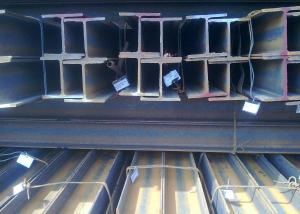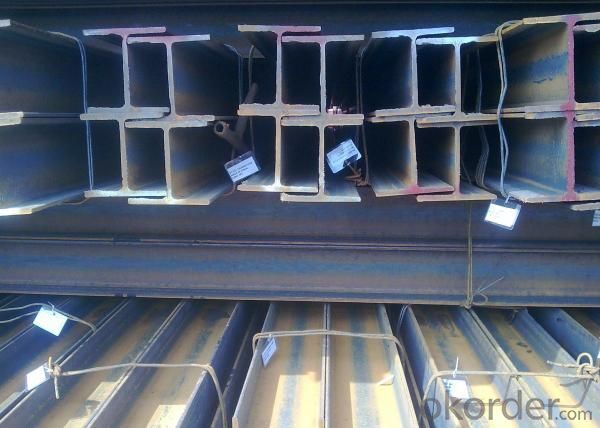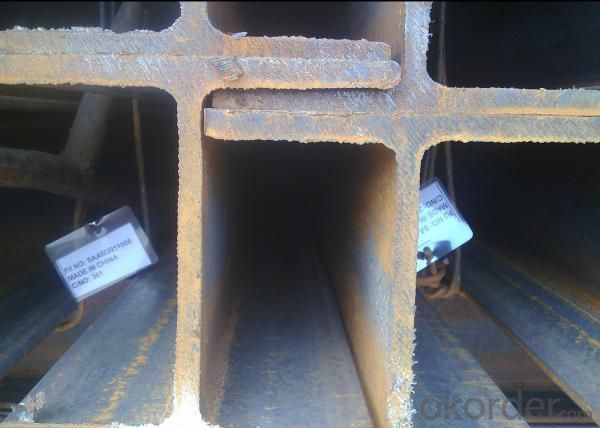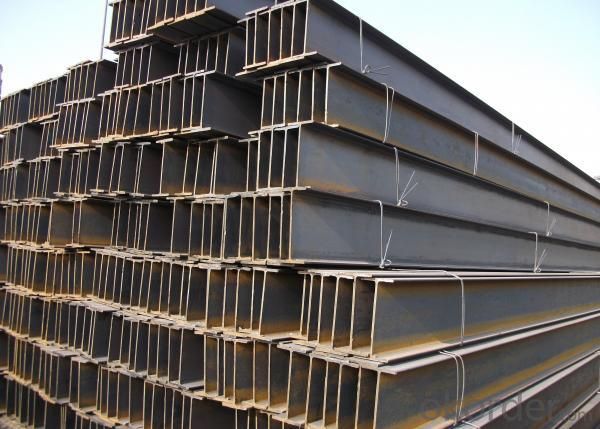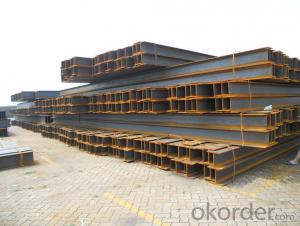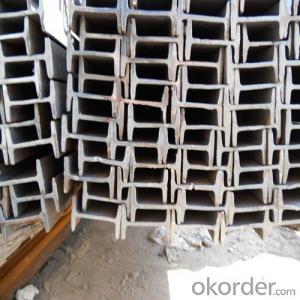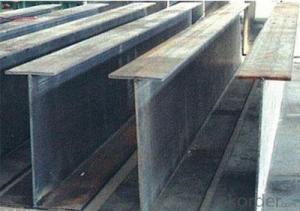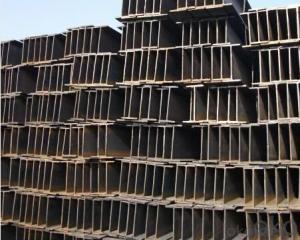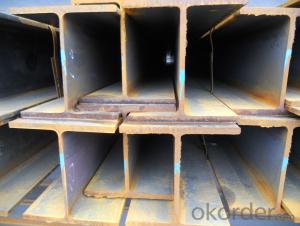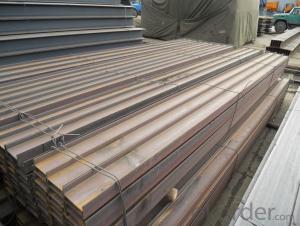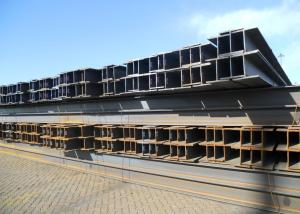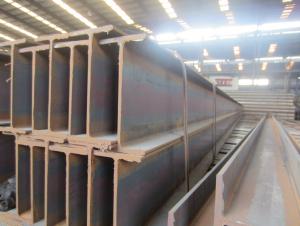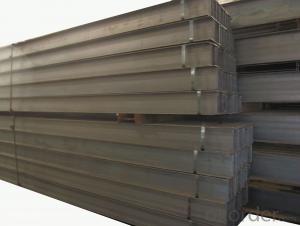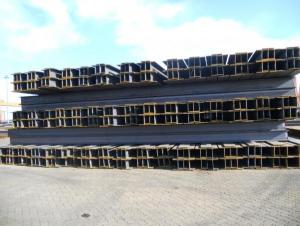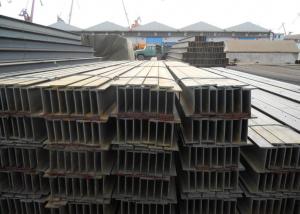Hot Rolled Alloy Constructural Steel H Beam
- Loading Port:
- China Main Port
- Payment Terms:
- TT or LC
- Min Order Qty:
- 100MT m.t.
- Supply Capability:
- 10000MT/month m.t./month
OKorder Service Pledge
OKorder Financial Service
You Might Also Like
Specifications of Hot Rolled Alloy Constructural Steel H Beam
1. Standard: HEA100-HEA500,HEB100-HEB500
2. Grade: Q235, SS400 or Equivalent
3. Length: 6m,10m, 12m as following table
4. Invoicing on theoretical weight or actual weight as customer request
5.Payment: TT or L/C
6. Sizes:
SIZE(mm) | DIMENSION(kg/m) |
100*100 | 16.9 |
125*125 | 23.6 |
150*75 | 14 |
150*150 | 31.1 |
148*100 | 20.7 |
198*99 | 17.8 |
200*100 | 20.9 |
248*124 | 25.1 |
250*125 | 29 |
300*150 | 36.7 |
298*149 | 32 |
200*200 | 49.9 |
294*200 | 55.8 |
346*174 | 41.2 |
350*175 | 49.4 |
244*175 | 43.6 |
175*175 | 40.4 |
294*200 | 55.8 |
298*201 | 64.4 |
346*174 | 41.2 |
350*175 | 49.4 |
400*200 | 65.4 |
396*199 | 56.1 |
450*200 | 74.9 |
446*199 | 65.1 |
340*250 | 78.1 |
500*200 | 88.1 |
300*150 | 36.7 |
Usage & Applications of Hot Rolled Alloy Constructural Steel H Beam
Commercial building structure ;Pre-engineered buildings; Machinery support structure; Prefabricated structure; Medium scale bridges; Ship-building structure. etc.
Packaging & Delivery of Hot Rolled Alloy Constructural Steel H Beam
1. Packing: it is nude packed in bundles by steel wire rod
2. Bundle weight: not more than 3.5MT for bulk vessel; less than 3 MT for container load
3. Marks:
Color marking: There will be color marking on both end of the bundle for the cargo delivered by bulk vessel. That makes it easily to distinguish at the destination port.
Tag mark: there will be tag mark tied up on the bundles. The information usually including supplier logo and name, product name, made in China, shipping marks and other information request by the customer.
If loading by container the marking is not needed, but we will prepare it as customer request.
4. Transportation: the goods are delivered by truck from mill to loading port, the maximum quantity can be loaded is around 40MTs by each truck. If the order quantity cannot reach the full truck loaded, the transportation cost per ton will be little higher than full load.
5. Delivered by container or bulk vessel
Production flow of Hot Rolled Alloy Constructural Steel H Beam
Material prepare (billet) —heat up—rough rolling—precision rolling—cooling—packing—storage and transportation
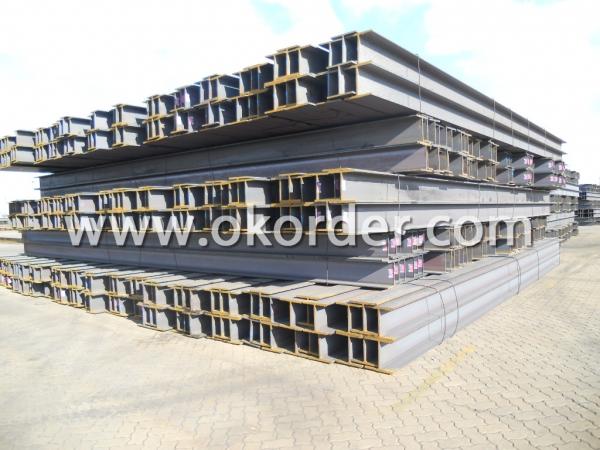
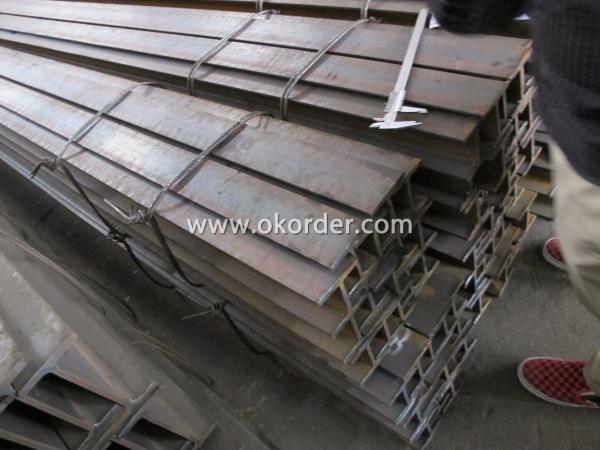
- Q: What are the common sizes of steel H-beams?
- The common sizes of steel H-beams vary depending on the specific needs and requirements of a project. However, there are several standard sizes that are commonly used in construction and engineering applications. Some of the most common sizes include: - W6x9: This size refers to a wide flange beam with a height of 6 inches and a weight per foot of 9 pounds. It is often used in residential construction or smaller structural applications. - W10x33: Another popular size, this wide flange beam has a height of 10 inches and weighs 33 pounds per foot. It is commonly used in commercial construction and larger structural projects. - W12x65: This wide flange beam has a height of 12 inches and weighs 65 pounds per foot. It is often used in heavy-duty construction projects or for supporting larger loads. - W18x76: With a height of 18 inches and a weight per foot of 76 pounds, this wide flange beam is commonly used in industrial applications or for supporting extremely heavy loads. - W36x135: This is one of the largest commonly available sizes of wide flange beams, with a height of 36 inches and weighing 135 pounds per foot. It is typically used in the construction of large-scale structures such as bridges or high-rise buildings. These are just a few examples of the common sizes of steel H-beams. It is important to consult with a structural engineer or reference specific industry standards to determine the appropriate size for a particular project, as the size requirements can vary depending on factors such as load capacity, span length, and structural design.
- Q: Why is it that the steel pile is low in cost and easy to construct, and it can be changed when there is an obstacle
- This is the specification of hot-rolled narrow flange section steel.Cross section 300, flange width 150, web thickness 6.5, flange thickness 9.
- Q: What are the different connection methods for steel H-beams?
- There are several different connection methods for steel H-beams, depending on the specific application and structural requirements. 1. Welding: One of the most common methods is welding. H-beams can be welded together using various welding techniques such as arc welding, gas metal arc welding (MIG), or shielded metal arc welding (stick welding). This method provides a strong and rigid connection between the beams. 2. Bolting: Another common method is bolting. H-beams can be connected using high-strength bolts and nuts. This method allows for easy disassembly and reassembly if necessary. It is important to ensure proper bolt size, torque, and spacing to achieve a secure connection. 3. Riveting: Riveting is an older method of connecting steel H-beams, but it is still used in some cases. This process involves drilling holes in the beams and inserting rivets, which are then hammered or compressed to secure the connection. Riveting provides a strong and durable connection, but it is more time-consuming compared to welding or bolting. 4. Moment connections: In structural applications where a high degree of rigidity and load-bearing capacity is required, moment connections can be used. These connections are designed to transmit both shear and moment forces between the beams, providing greater stability and resistance to bending moments. 5. Composite connections: In some cases, steel H-beams may be connected to other materials such as concrete or timber. Composite connections involve combining the properties of different materials to enhance structural performance. This can be achieved by using shear connectors, adhesive bonding, or mechanical fasteners. It is worth noting that the specific connection method chosen will depend on factors such as the load requirements, structural design, available equipment, and the skills and expertise of the construction team. Proper engineering analysis and design are crucial to ensure a safe and efficient connection method for steel H-beams.
- Q: Are steel H-beams suitable for use in coastal areas?
- Indeed, steel H-beams prove to be a fitting choice for implementation in coastal regions. The exceptional resistance of steel, particularly when it comes to top-grade stainless steel, towards corrosion renders it a suitable material for employment in coastal settings where the likelihood of exposure to saltwater and humidity is heightened. Steel H-beams find widespread application in coastal areas for a variety of construction purposes such as bridges, piers, and marine structures due to their commendable strength, enduring nature, and capacity to withstand corrosion. Furthermore, steel H-beams exhibit the ability to endure the formidable winds and harsh climatic conditions often encountered in coastal regions, thus establishing themselves as a dependable option for construction ventures in these areas.
- Q: How do steel H-beams contribute to the overall flexibility and adaptability of a structure?
- Steel H-beams contribute to the overall flexibility and adaptability of a structure by providing a strong and versatile structural support system. These beams can be easily modified or resized to meet the changing needs of a building or structure. Additionally, their high strength-to-weight ratio allows for longer spans and greater load-bearing capacity, enabling architects and engineers to design more flexible spaces and accommodate various layout changes.
- Q: Are steel H-beams resistant to electrical conductivity?
- Steel H-beams are not completely resistant to electrical conductivity. While steel is generally considered a poor conductor of electricity compared to materials like copper or aluminum, it can still conduct electricity to some extent. The electrical conductivity of steel is influenced by factors such as its composition and impurities present. In general, steel H-beams have a relatively low electrical conductivity compared to other metals, but they can still conduct electricity under certain conditions. Therefore, it is important to take proper precautions when working with steel H-beams in electrical installations to avoid any potential risks.
- Q: How do steel H-beams contribute to sustainable building practices?
- Steel H-beams contribute to sustainable building practices in several ways. Firstly, steel is a highly durable material with a long lifespan, ensuring that the H-beams will last for decades without requiring replacement. This longevity reduces the need for frequent maintenance and repairs, thereby minimizing the consumption of additional resources and energy. Secondly, steel is one of the most recyclable materials in the world. H-beams can be easily dismantled and recycled at the end of their useful life, creating a closed-loop system where the steel can be reused in the manufacturing of new products. This reduces the demand for raw materials and decreases the amount of waste ending up in landfills. Furthermore, steel H-beams are lightweight yet incredibly strong, enabling the construction of large and complex structures with minimal materials. This efficient use of steel not only reduces the environmental impact associated with its production but also allows for more efficient transportation and assembly, saving energy and reducing carbon emissions during construction. Steel is also known for its fire resistance, providing an added layer of safety to buildings. This fire resistance reduces the risk of structural damage, minimizing the need for reconstruction and the associated consumption of resources in the event of a fire. Lastly, steel H-beams can be prefabricated off-site, reducing construction time and minimizing disruption to the surrounding environment. This off-site construction also allows for more precise manufacturing and quality control, resulting in less waste and a more sustainable building process. In conclusion, steel H-beams contribute to sustainable building practices through their durability, recyclability, lightweight nature, fire resistance, and prefabrication capabilities. By utilizing steel H-beams, builders can achieve sustainable structures that are not only environmentally friendly but also economically viable and safe.
- Q: Are steel H-beams suitable for structures with high humidity?
- Steel H-beams are generally suitable for structures with high humidity. This is because steel is known for its durability and resistance to moisture. However, it is important to consider the specific conditions and level of humidity in the structure. If the humidity levels are extremely high or if there is constant exposure to moisture, additional measures may need to be taken to prevent corrosion and ensure the longevity of the H-beams. These measures can include applying protective coatings or using stainless steel beams, which have a higher resistance to corrosion.
- Q: What are the different bolt sizes used for steel H-beams?
- There are several different bolt sizes commonly used for steel H-beams, depending on the specific application and load requirements. The most commonly used bolt sizes for steel H-beams include M12, M16, M20, and M24. These bolt sizes are determined based on the strength and load capacity needed for the specific steel H-beam structure. Additionally, the length of the bolts may vary depending on the thickness and width of the H-beam. It is important to consult engineering specifications and calculations to determine the appropriate bolt sizes for a particular steel H-beam structure to ensure optimal strength and stability.
- Q: What are the mechanical properties of steel H-beams?
- The mechanical properties of steel H-beams include high strength, stiffness, and durability. They have excellent load-bearing capacity, making them suitable for structural applications. Additionally, steel H-beams exhibit good resistance to bending, torsion, and compression forces. The specific mechanical properties may vary depending on the grade and composition of the steel used.
1. Manufacturer Overview
| Location | Tangshan, China |
| Year Established | 2009 |
| Annual Output Value | Above US$ 230 Million |
| Main Markets | Mid East; Southeast Asia; Korea |
| Company Certifications | ISO 9001:2008; |
2. Manufacturer Certificates
| a) Certification Name | |
| Range | |
| Reference | |
| Validity Period |
3. Manufacturer Capability
| a) Trade Capacity | |
| Nearest Port | Tianjin; |
| Export Percentage | 81% - 90% |
| No.of Employees in Trade Department | 21-50 People |
| Language Spoken: | English; Chinese; |
| b) Factory Information | |
| Factory Size: | Above 500,000 square meters |
| No. of Production Lines | 1 |
| Contract Manufacturing | OEM Service Offered; |
| Product Price Range | Average |
Send your message to us
Hot Rolled Alloy Constructural Steel H Beam
- Loading Port:
- China Main Port
- Payment Terms:
- TT or LC
- Min Order Qty:
- 100MT m.t.
- Supply Capability:
- 10000MT/month m.t./month
OKorder Service Pledge
OKorder Financial Service
Similar products
Hot products
Hot Searches
Related keywords
